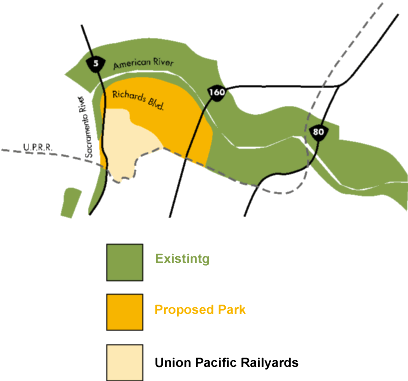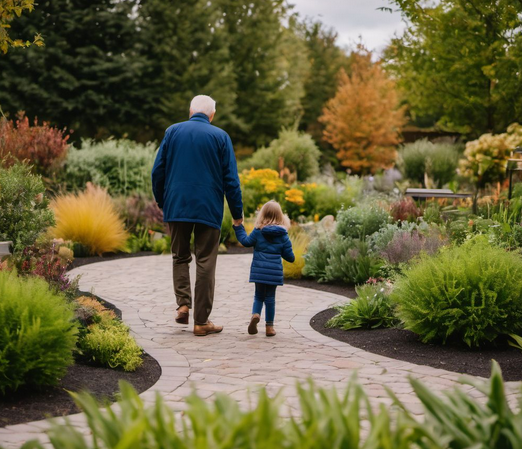Gold Rush Park
Sacramento, California
Landscape Architecture 181M
Urban and Community Design
University of California, Davis
Winter 2005

Julia Cox, Jennifer Egawa, Robert Seed

Julia Cox, Jennifer Egawa, Robert Seed
Gold Rush Park would reclaim the industrial tract known as the Richards Boulevard corridor to provide Sacramento's "Central Park." The area encompasses hundreds of acres, bordering on two premier recreational assets--Old Sacramento and the American River Parkway. The park would connect downtown Sacramento and West Sacramento to Cal Expo and CSUS in a cultural and recreational corridor of world-class extent and content. It would encourage the riverfront development, helping revitalize West Sacramento and East Yolo. (Gold Rush Park Foundation, 2004)
In Fall 2004, Joe Genshlea and the Gold Rush Park Foundation asked Mark Francis, FASLA, professor of landscape architecture at UC Davis to help them develop a design concept for a proposed 1000 acre park and new mixed use development adjacent to downtown Sacramento and the American and Sacramento Rivers. The park would be 35 times larger than Old Sacramento, 25 times larger than Capital Park and 6 times larger than Land Park in Sacramento. It would rival Central Park in New York City and Golden Gate Park in San Francisco in size and importance.

During the ten-week Winter quarter 2005, eighteen undergraduate landscape architecture students in his Urban and Community Design Studio at UC Davis developed five alternative designs for the project. These include pastoral, contemporary and ecological park designs. The plans were presented to the Gold Rush Park Board and their major donors in Sacramento on March 16, 2005.
As part of the project, the students developed case studies of 18 large urban parks of similar size and scope around the world. They included the American River Parkway, Sacramento, California, Amsterdamse Bos, Amsterdam, The Netherlands, Balboa Park, San Diego, California, Boston Common and Public Gardens, Boston, Massachusetts, Casa De Campo, Madrid, Spain, Chain of Lakes, Minneapolis, Minnesota, Central Park, New York, NY, Franklin Park, Boston, Massachusetts, USA, Frogner Park, Oslo, Norway, Golden Gate Park, San Francisco, California, Hyde Park, London, England, Landschaftspark Duisburg-Nord, Duisburg, Germany, Luxembourg Gardens, Paris, France, The Mall, Washington, DC, Millennium Park, Chicago, Illinois, National Park of Tijuca, Rio de Janeiro, Brazil Parc de la Villette, Paris, France, and Stanley Park, Vancouver, British Columbia, Canada. The students also conducted in teams site and urban design analysis including land use, transportation, open space, river ecology, and park programming.

Elizabeth Collett, Chriselda Cruz, Ethan Kong, Justine Smith

Michael Harris, Kari Koch, Eric Mullin, Darren Solano

Julia Cox, Jennifer Egawa, Robert Seed

The following program elements were included in the designs. In addition, other mixed-use development such as housing, office space, cultural facilities and recreational uses are proposed:
- A central green or plaza for city wide or regional events
- Performing Arts and Music Center
- A new zoo (on par with the San Diego Zoo)
- Expanded access to the American and Sacramento Rivers for fishing, boating, swimming, etc.
- Water taxi and shuttle systems between the downtown, Old Sacramento, Cal Expo and the new park
- A new small boat marina
- An Exploratorium or similar science museum
- An environmental education and natural history center
- A Museum of California Culture
- A major horticulture or botanical garden
- Recreational uses such as soccer fields, etc.
- Bike and hiking trails
- Traffic access and parking
- Relocation or realignment of Richards Blvd.
- Access from a proposed intermodal transit station being planned in the adjacent train yards

Elizabeth Collett, Chriselda Cruz, Ethan Kong, Justine Smith
A number of common elements are included in the plans:
- All create a clear center for the park with space for up to one million people to gather
- All reconnect the central city to the American and Sacramento Rivers
- All incorporate water either with central water features, canals or diverting part of the American River through the site to reestablish part of the prehistoric riparian landscape
- All preserve some important buildings on 12/16th St. as a cultural park zone or new urban village
- All connect to the larger regional transit, walking and biking network and add many miles of new trails
- All make Sacramento “a go to place”

Elizabeth Collett, Chriselda Cruz, Ethan Kong, Justine Smith

Elizabeth Collett, Chriselda Cruz, Ethan Kong, Justine Smith

Jessica Chase, Chris Chisam, Sara Fix, Linsey Pane

Jocelyn Brodeur, Sarah Hayward, Martha L. Lopez

Michael Harris, Kari Koch, Eric Mullin, Darren Solano
We would like to acknowledge support from the University of California Transportation Center and the Gold Rush Park Foundation for this project.
Recent news articles on the student projects can be found here, here and here.
Contact information: Professor Mark Francis, (530) 752-6031. mofrancis@ucdavis.edu
